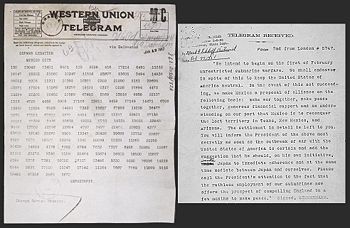Zimmerman Telegram
The Zimmerman Telegram was a 1917 proposal from Germany to Mexico to make war against the United States. It was ignored by Mexico but angered Americans, and hastened U.S. involvement in World War I. Wilson historian Arthur S. Link called it "one of the most ... monstrous blunders in diplomatic history."[1]
In January 1917 Germany decided on unrestricted submarine warfare in order to defeat Britain and win World War I. Every since the sinking of the passenger liner RMS Lusitania in 1915 Germany had repeatedly promised the United States it would restrain its u-boats (see Sussex Pledge). It knew the new policy meant war with the United States and, in preparation for that war, it made overtures to Mexico to join Germany, and perhaps also involve Japan. Mexico, in the midst of its civil war, was at sword’s point with the U.S., and Germany had designs on taking over Mexico as its satellite. The U.S. severed diplomatic relations with Germany on February 3, 1917.
On February 24 the British delivered to the U.S. ambassador in London an intercepted German telegram, dated January 19, sent by German Foreign Secretary Arthur Zimmerman to the German minister in Mexico City. British naval intelligence had intercepted and partly decoded the telegraphic message (see Room 40), and a British spy in Mexico City bribed the local post office for another copy. Germany admitted the note was genuine.
The message told the ambassador to tell Mexico that unrestricted submarine warfare would begin on February 1. Assuming that war would soon begin with the U.S., Zimmerman directed the ambassador to arrange a military alliance between Mexico and Germany, and to urge Japan to switch to the German side. Mexico would receive German guidance and financing during the war. Mexico, realizing its hopeless position next to a much more powerful neighbor, ignored the proposal.
President Woodrow Wilson released the note to the press on March 1, 1917, causing a firestorm of protest and demands for a declaration of war against Germany.
Bibliography
- Boghardt, Thomas. "The Zimmermann Telegram: Diplomacy, Intelligence and the American Entry. into World War I." (working paper 2003) online edition
- Beesly, Patrick. Room 40: British Naval Intelligence, 1914-18. (1982).
- Freeman, Peter. "The Zimmermann Telegram Revisited: A Reconciliation of the Primary Sources." Cryptologia 30, no. 2 (Apr. 2006): 98-150.
- Friedman, William F., and Charles J. Mendelsohn. The Zimmermann Telegram of January 16, 1917 and Its Cryptographic Background. Washington: War Department, Office of the Chief Signal Officer, GPO, 1938, reprinted 1976 and 1994
- Katz, Friedrich. The Secret War in Mexico: Europe, the United States, and the Mexican Revolution. (1981)
- Link, Arthur S. Wilson: Campaigns for Progressivism and Peace: 1916-1917 (1965), the standard biography online at ACLS e-books; login required.
- Tuchman, Barbara W. The Zimmerman Telegram (1985) excerpt and text search
External links
Notes
- ↑ Arthur S. Link, Wilson: Campaigns for Progressivism and Peace, 1916-1917. (Princeton University Press, 1965), 5:346.
